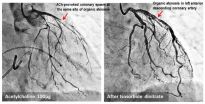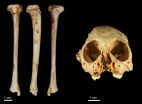(Press-News.org) Fewer patients are admitted at weekends, but are more likely to be sicker and have a higher risk of death from Friday through until Monday
Authors caution against using the data to estimate avoidable deaths, but call for more research into how services can be improved to reduce risk
Patients admitted to hospital at the weekend are more likely to be sicker and have a higher risk of death, compared with those admitted during the week, finds an analysis published in The BMJ this week.
The analysis was carried out as a collaboration between University Hospital Birmingham NHS Foundation Trusts and University College London, and included Sir Bruce Keogh, National Medical Director of NHS England. It examined the effect of hospital admission day on death rates across NHS England hospitals for 2013-2014.
The results confirm findings from an analysis they undertook for 2009-2010.
In the latest analysis, the authors found that around 11,000 more people die each year within 30 days of admission to hospital on Friday, Saturday, Sunday, or Monday compared with other days of the week (Tuesday, Wednesday, Thursday).
This suggests a generalised "weekend effect" which can be partly explained by the reduced support services that start from late Friday through the weekend, leading to disruption on Monday morning, say the authors. Patients already in hospital over the weekend do not have an increased risk of death.
These results remained the same even when taking into account the severity of illness.
The authors caution that it is not possible to show that this excess number of deaths could have been prevented, adding that to do so would be "rash and misleading."
Nevertheless, they say the number is "not otherwise ignorable" and "we need to determine exactly which services need to be improved at the weekend to tackle the increased risk of mortality."
They also looked at patient characteristics, length of hospital stay, and time to death.
An average of 2.7 million patients were admitted to hospital on each weekday, while an average of 1.2 million patients were admitted on a Saturday and 1 million patients admitted on a Sunday.
Saturday and Sunday admissions were more likely to be emergencies, 50% and 65% respectively, than on weekdays (29%) and length of stay was also higher for patients admitted on a Saturday and Sunday.
A higher proportion of patients admitted on a Saturday and Sunday had diagnoses that placed them in the highest risk of death category, 24.6% and 29.2% respectively, compared with less than 20% of weekday admissions.?
The debate on seven day working was reignited following health secretary Jeremy Hunt's recent call for hospital doctors to work at weekends to improve quality of care and reduce deaths.
But an accompanying feature article by Helen Crump at the Nuffield Trust says it is not clear how or to what extent investment in seven day services will reduce weekend deaths, and that the costs may outweigh any benefits.
She also warns that, unless overall staffing levels increase, ramping up services at the weekend "will leave a gap in the hospital's weekday rota, with potentially serious consequences across other services."
In a linked editorial, Paul Aylin, from Imperial College London, suggests more research is needed to determine the "complex" relation between staffing levels and services, and patient safety. He says promised changes to how the NHS provides weekend and out of hours care "will be an ideal opportunity to evaluate their impact on the weekend effect."
Seven day working has also been a central part of negotiations between the government and doctors about proposed changes to the standard contract for NHS consultants. Hunt announced that the government would remove a clause in the contract which allowed doctors to opt out of non-emergency work at weekends. But figures obtained from freedom of information requests by BMJ Careers show that just 1% of consultants have opted out of non-emergency weekend work.
INFORMATION:
Action to prevent tooth decay in children, such as supervised tooth brushing and fluoride varnish schemes, are not just beneficial to children's oral health but could also result in cost savings to the NHS of hundreds of pounds per child, so says a leading dental health researcher.
Professor Elizabeth Kay, Foundation Dean of the Peninsula Dental School from Plymouth University Peninsula Schools of Medicine and Dentistry, has carried out the first economic evaluation of public health measures to reduce tooth decay in children at high risk, in association with the National ...
An international team of scientists has developed what may be the first one-step process for making seamless carbon-based nanomaterials that possess superior thermal, electrical and mechanical properties in three dimensions.
The research holds potential for increased energy storage in high efficiency batteries and supercapacitors, increasing the efficiency of energy conversion in solar cells, for lightweight thermal coatings and more. The study is published today (Sept. 4) in the online journal Science Advances.
In early testing, a three-dimensional (3D) fiber-like ...
Washington, DC - September 4, 2015 - Decontamination protocols eradicated both methicillin-resistant Staphylococcus aureus (MRSA) and antibiotic resistant, pathogenic intestinal bacteria, the Enterobacteriaceae, from a pig farm. The research appears online September 4th in ASM's journal Applied and Environmental Microbiology.
The study involved a farm on which both pathogens had been discovered through routine monitoring. The farmer had approached the investigators for help. The Enterobacteriaceae were expressing resistance genes called extended-spectrum β-lactamases ...
WINSTON-SALEM, N.C. - Sept. 4, 2015 - A commonly prescribed antidepressant may alter brain structures in depressed and non-depressed individuals in very different ways, according to new research at Wake Forest Baptist Medical Center.
The study - conducted in nonhuman primates with brain structures and functions similar to those of humans - found that the antidepressant sertraline, a selective serotonin reuptake inhibitor (SSRI) marketed as Zoloft, significantly increased the volume of one brain region in depressed subjects but decreased the volume of two brain areas in ...
Far above the wildfires raging in Washington's forests, a less noticeable consequence of this dry year is taking place in mountain ponds. The minimal snowpack and long summer drought that have left the Pacific Northwest lowlands parched also affect the region's amphibians due to loss of mountain pond habitat.
According to a new paper published Sept. 2 in the open-access journal PLOS ONE, this summer's severe conditions may be the new normal within just a few decades.
"This year is an analog for the 2070s in terms of the conditions of the ponds in response to climate," ...
The misery of motion sickness could be ended within five to ten years thanks to a new treatment being developed by scientists.
The cause of motion sickness is still a mystery but a popular theory among scientists says it is to do with confusing messages received by our brains from both our ears and eyes, when we are moving.
It is a very common complaint and has the potential to affect all of us, meaning we get a bit queasy on boats or rollercoasters. However, around three in ten people experience hard-to-bear motion sickness symptoms, such as dizziness, severe nausea, ...
This news release is available in Japanese.
Researchers at Kumamoto University in Japan have found that patients with coronary spasm have a higher risk of experiencing future heart attack particularly when a spasm occurs at the site of atherosclerotic coronary artery narrowing, i.e., coronary atherosclerotic stenosis.
Angina is caused by the narrowing of the blood vessels that carry blood to the heart, and vasospastic angina patients account for about 40% of all angina patients. The incidence and progression of the disease can be reduced through appropriate drug treatment ...
ALLENDALE, Mich. -- An international team of scientists, including a Grand Valley State University professor and alumni, recently discovered a species of monkey fossil the team has dated to be more than one million years old.
The discovery was made after the team recovered a fossil tibia (shin bone) belonging to the species of extinct monkey Antillothrix bernensis from an underwater cave in Altagracia Province, Dominican Republic. The species was roughly the size of a small cat, dwelled in trees, and lived largely on a diet of fruits and leaves.
"We know that there ...
As climate change accelerates ice melt in the Arctic, polar bears may find caribou and snow geese replacing seals as an important food source, shows a recent study published in the journal PLOS ONE. The research, by Linda Gormezano and Robert Rockwell at the American Museum of Natural History, is based on new computations incorporating caloric energy from terrestrial food sources and indicates that the bears' extended stays on land may not be as grim as previously suggested.
"Polar bears are opportunists and have been documented consuming various types and combinations ...
Natural wonders like tumbling waterfalls, jutting rock faces and banks of wildflowers have long drawn visitors to America's national parks and inspired efforts to protect their beauty.
According to a study published Sept. 4 in Park Science, visitors also value and seek to protect a different kind of threatened natural resource in the parks: dark nighttime skies.
Almost 90 percent of visitors to Maine's Acadia National Park interviewed for the study agreed or strongly agreed with the statements, "Viewing the night sky is important to me" and "The National Park Service ...





